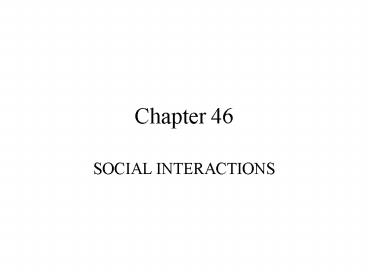SOCIAL INTERACTIONS - PowerPoint PPT Presentation
1 / 19
Title:
SOCIAL INTERACTIONS
Description:
e.g. red-spot packing gull chicks. egg- rolling goose. swallowing reflexes. Male song ... colonies of social insects are sterile: e.g. termites and honeybees ... – PowerPoint PPT presentation
Number of Views:257
Avg rating:3.0/5.0
Title: SOCIAL INTERACTIONS
1
Chapter 46
- SOCIAL INTERACTIONS
2
Ethology
- The study of the behavior of organisms in their
natural environment
3
Mechanisms Underlying Behavior
- Genetic Basis of Behavior
- Involves coordinated responses to internal and
external responses - Genes contribute in an indirect way
- e.g., garter snakes in California
(coastal/inland) - Hormonal Effects on Behavior
- Hormones signaling molecules
- e.g., songbirds in response to photoperiod
changes
4
(No Transcript)
5
Behavior Response
- Animals depend on structural and physiological
mechanisms that govern behavior response to
environmental cues. - Two categories
- Instinctive (innate)
- learned
6
1. Innate (Instinctive) Behavior
- Components of the nervous system allow an animal
to accomplish complex, stereotyped responses to
certain environmental cues - Fixed action patterns
- Simple, lasting long, resistant to changes
- e.g. red-spot packing gull chicks
- egg- rolling goose
- swallowing reflexes
7
Male song
Song of female experimentally converted to singer
8
2. Learned Behavior
- Incorporates information that has been gained
from specific experience - Imprinting Konrad Lorenz exp. (1930s),
Canadian geese story - Habituation
- Operant Conditioning (Trial-and-error learning)
- Classical Conditioning
- Spatial (Latent) learning
- Insight Learning
9
The Adaptive Value of Behavior
- Behavioral Evolution
- Reproductive success refers to the survival and
production of offspring by - adaptive behavior,
- selfish behavior,
- altruistic behavior, and
- natural selection (on feeding behavior and mating
behavior) ? adaptive reproductive behavior
10
- Evolution of Altruism
- Reduction in helpers Increased reproduction
of helped. - Human Behavior
- The behavior is valuable in the transmission of
an individual genes - Selfish / altruistic behavior of human can be
tested w/o justifying the behavior, - e.g., adopting children
11
Social Life
- Social behavior is the the tendency of
individual animals to enter into cooperative,
interdependent relationships with others of their
kind ? requires - communication signals
- Pheromones
- Visual signals
- Acoustical signals
- Tactile signals
12
Round dance signals food close to hive
13
(No Transcript)
14
Waggle dance signals food 100 meters from hive
Orientation of straight run shows direction to
food
15
(No Transcript)
16
Subordinate member of a wolfpack
17
Cooperative defensive behavior among musk oxen
(Ovibos moschatus)
18
Costs of Social Life
- Increased competition for food, mates, and other
limiting resources - Increased vulnerability to disease and parasitism
- Risk of exploitation by other group members
19
Social Insects
- Workers in colonies of social insects are
sterile e.g. termites and honeybees - These colonies are extended families
- Workers pass on their genes indirectly by helping
relatives reproduce

